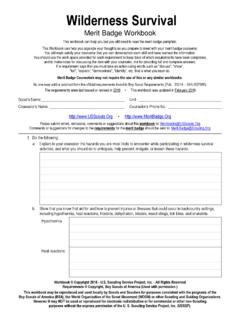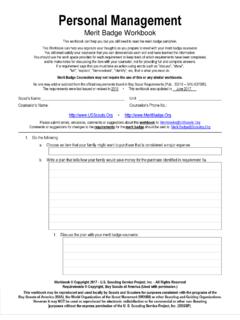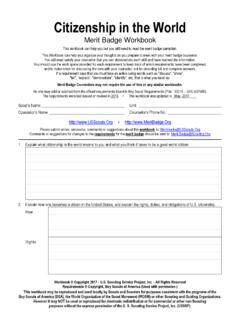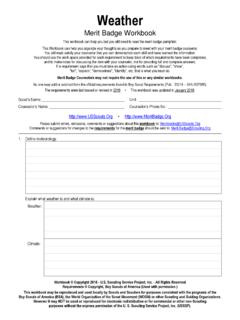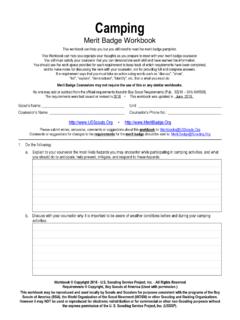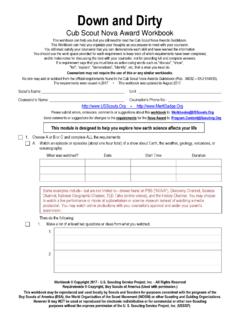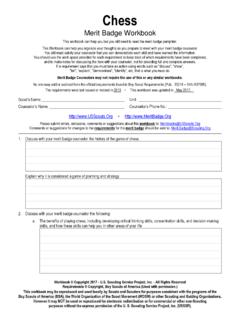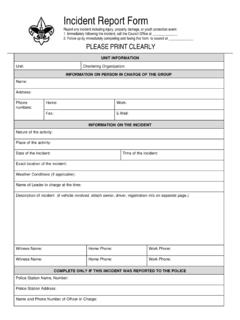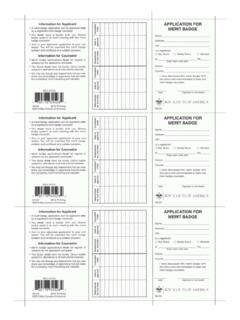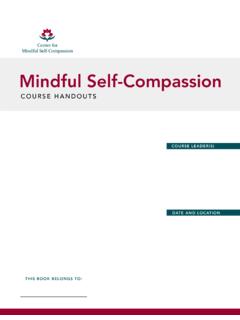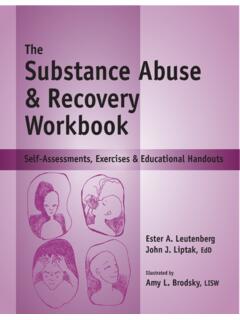Transcription of Swimming - U.S. Scouting Service Project
1 Swimming Merit Badge workbook This workbook can help you but you still need to read the merit badge pamphlet. This workbook can help you organize your thoughts as you prepare to meet with your merit badge counselor. You still must satisfy your counselor that you can demonstrate each skill and have learned the information. You should use the work space provided for each requirement to keep track of which requirements have been completed, and to make notes for discussing the item with your counselor, not for providing full and complete answers. If a requirement says that you must take an action using words such as "discuss", "show", "tell", "explain", "demonstrate", "identify", etc, that is what you must do. Merit Badge Counselors may not require the use of this or any similar workbooks. No one may add or subtract from the official requirements found in Boy Scout Requirements (Pub. 33216 SKU 621535). The requirements were last issued or revised in 2015 This workbook was updated in June 2017.
2 Scout's Name:_____ Unit: _____. Counselor's Name: _____ Counselor's Phone No.: _____. Please submit errors, omissions, comments or suggestions about this workbook to: Comments or suggestions for changes to the requirements for the merit badge should be sent to: _____. 1. Do the following: a. Explain to your counselor how Scouting 's Safe Swim Defense plan anticipates, helps prevent and mitigate, and provides responses to likely hazards you may encounter during Swimming activities. b. Discuss the prevention and treatment for health concerns that could occur while Swimming , including hypothermia, dehydration, sunburn, heat exhaustion, heatstroke, muscle cramps, spinal injuries, hyperventilation. stings and bites, and cuts and scrapes. Hypothermia: Dehydration: workbook Copyright 2017 - Scouting Service Project , Inc. - All Rights Reserved Requirements Copyright, Boy Scouts of America (Used with permission.). This workbook may be reproduced and used locally by Scouts and Scouters for purposes consistent with the programs of the Boy Scouts of America (BSA), the World Organization of the Scout Movement (WOSM) or other Scouting and Guiding Organizations.
3 However it may NOT be used or reproduced for electronic redistribution or for commercial or other non- Scouting purposes without the express permission of the U. S. Scouting Service Project , Inc. (USSSP). Swimming Scout's Name: _____. Sunburn: Heat exhaustion: Heatstroke: Muscle cramps: Spinal injuries: Hyperventilation: Stings and bites: Cuts and scrapes: 2. Before doing the following requirements, successfully complete the BSA swimmer test: Jump feet first into water over your head in depth, swim 75 yards in a strong manner using one or more of the following strokes: sidestroke, breaststroke, trudgen, or crawl; then swim 25 yards using an easy, resting backstroke. The 100. yards must be swum continuously and include at least one sharp turn. After completing the swim, rest by floating. Swimming - Merit Badge workbook Page. 2 of 8. Swimming Scout's Name: _____. 3. Swim continuously for 150 yards using the following strokes in good form and in a strong manner: front crawl or trudgen for 25 yards, back crawl for 25 yards, sidestroke for 25 yards, breaststroke for 25 yards, and elementary backstroke for 50 yards.
4 4. Do the following: a. Demonstrate water rescue methods by reaching with your arm or leg, by reaching with a suitable object, and by throwing lines and objects. Explain why Swimming rescues should not be attempted when a reaching or throwing rescue is possible, and explain why and how a rescue swimmer should avoid contact with the victim. b. With a helper and a practice victim, show a line rescue both as tender and as rescuer. The practice victim should be approximately 30 feet from shore in deep water. 5. Do the following: a. Float face up in a resting position for at least one minute. b. Demonstrate survival floating for at least five minutes. c. While wearing a properly fitted Coast Guard approved life jacket, demonstrate the HELP and huddle positions. Explain their purposes. d. Explain why Swimming or survival floating will hasten the onset of hypothermia in cold water. Swimming - Merit Badge workbook Page. 3 of 8. Swimming Scout's Name: _____.
5 6. In water over your head, but not to exceed 10 feet, do each of the following: a. Use the feet first method of surface diving and bring an object up from the bottom. b. Do a headfirst surface dive (pike or tuck), and bring the object up again. c. Do a headfirst surface dive to a depth of at least 5 feet and swim underwater for 3 strokes. Come to the surface, take a breath, and repeat the sequence twice. 7. Following the guidelines set in the BSA Safe Swim Defense, in water at least 7 feet deep*, show a standing headfirst dive from a dock or pool deck. Show a long shallow dive, also from the dock or pool deck. * If your state, city, or local community requires a water depth greater than 7 feet, it is important to abide by that mandate. 8. Explain the health benefits of regular aerobic exercise , and discuss why Swimming is favored as both fitness and therapeutic exercise . When working on merit badges, Scouts and Scouters should be aware of some vital information in the current edition of the Guide to Advancement (BSA publication 33088).
6 Important excerpts from that publication can be downloaded from You can download a complete copy of the Guide to Advancement from Swimming - Merit Badge workbook Page. 4 of 8. SAFETY AFLOAT Page 1 of 2. BSA groups shall use Safety Afloat for all boating activities. Adult 3. Swimming Ability leaders supervising activities afloat must have completed Safety Operation of any boat on a float trip is limited to youth and Afloat training within the previous two years. Cub Scout activities adults who have completed the BSA swimmer classification afloat are limited to council or district events that do not include test. Swimmers must complete the following test, which moving water or float trips (expeditions). Safety Afloat standards should be administered annually. apply to the use of canoes, kayaks, rowboats, rafts, floating tubes, sailboats, motorboats (including waterskiing), and other small Jump feetfirst into water over the head in depth.
7 Level off craft, but do not apply to transportation on large commercial and swim 75 yards in a strong manner using one or more of vessels such as ferries and cruise ships. Parasailing (being towed the following strokes: sidestroke, breaststroke, trudgen, or airborne behind a boat using a parachute), kitesurfing (using a crawl; then swim 25 yards using an easy, resting backstroke. wakeboard towed by a kite), and recreational use of personal The 100 yards must be completed in one swim without stops watercraft (small sit-on-top motorboats propelled by water jets) are and must include at least one sharp turn. After completing not authorized BSA activities. the swim, rest by floating. Safety Afloat training may be obtained from the BSA Online For activity afloat, those not classified as a swimmer are Learning Center at , at council summer camps, limited to multiperson craft during outings or float trips on and at other council and district training events.
8 Confirmation of calm water with little likelihood of capsizing or falling training is required on local and national tour permits for trips that overboard. They may operate a fixed-seat rowboat or pedal involve boating. Additional guidance on appropriate skill levels boat accompanied by a buddy who is a swimmer. They may and training resources is provided in the Aquatics Supervision ride in a canoe or other paddle craft with an adult swimmer guide available from council Service centers. skilled in that craft as a buddy. They may ride as part of a group on a motorboat or sailboat operated by a skilled adult. 1. Qualified Supervision 4. Life Jackets All activity afloat must be supervised by a mature and conscientious adult age 21 or older who understands and Properly fitted Coast Guard approved life jackets must knowingly accepts responsibility for the wellbeing and safety be worn by all persons engaged in boating activity (rowing, of those in his or her care and who is trained in and canoeing, sailing, boardsailing, motorboating, waterskiing, committed to compliance with the nine points of BSA Safety rafting, tubing, and kayaking).
9 Type III life jackets are Afloat. That supervisor must be skilled in the safe operation recommended for general recreational use. of the craft for the specific activity, knowledgeable in accident prevention, and prepared for emergency situations. If the For vessels over 20 feet in length, life jackets need not be worn when participants are below deck or on deck when the adult with Safety Afloat training lacks the necessary boat operating and safety skills, then he or she may serve as the qualified supervisor aboard the vessel determines that it is supervisor only if assisted by other adults, camp staff prudent to abide by less-restrictive state and federal regulations concerning the use and storage of life jackets, for personnel, or professional tour guides who have the appropriate skills. Additional leadership is provided in ratios example, when a cruising vessel with safety rails is at of one trained adult, staff member, or guide per 10 anchor.
10 All participants not classified as swimmers must participants. For Cub Scouts, the leadership ratio is one wear a life jacket when on deck underway. trained adult, staff member, or guide per five participants. At Life jackets need not be worn when an activity falls under least one leader must be trained in first aid including CPR. Safe Swim Defense guidelines for example, when an Any Swimming done in conjunction with the activity afloat inflated raft is used in a pool or when snorkeling from an must be supervised in accordance with BSA Safe Swim anchored craft. Defense standards. It is strongly recommended that all units have at least one adult or older youth member currently 5. Buddy System trained in BSA Aquatics Supervision: Paddle Craft Safety to All participants in an activity afloat are paired as buddies who assist in the planning and conduct of all activities afloat. are always aware of each other's situation and prepared to 2.
